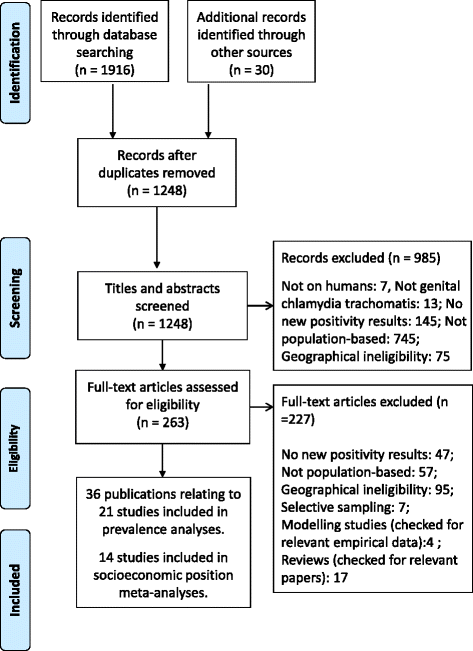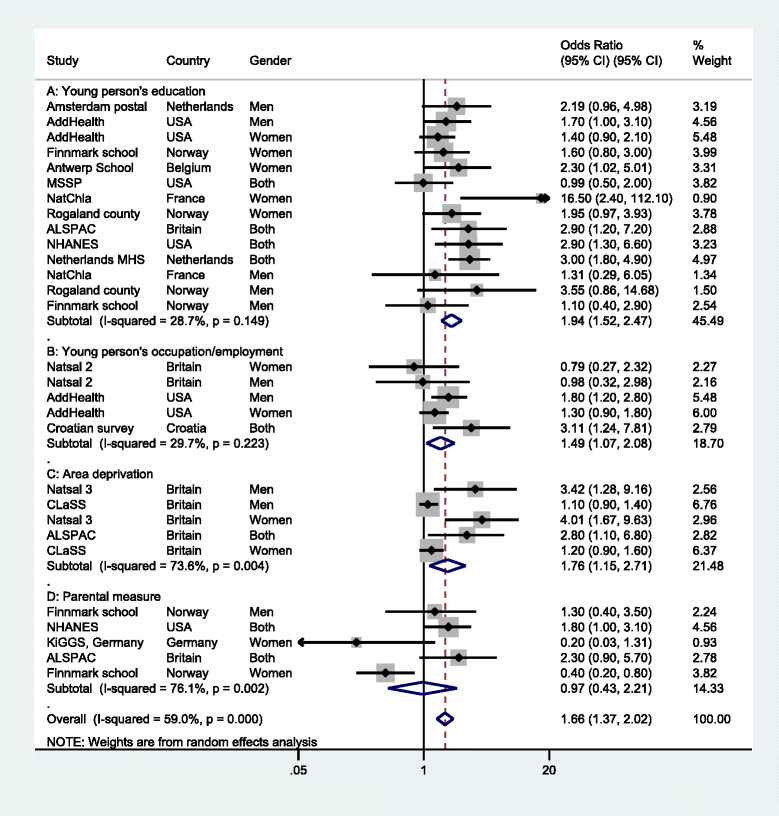Socioeconomic factors and other sources of variation in the prevalence of genital chlamydia infections: A systematic review and meta-analysis
- PMID: 26224062
- PMCID: PMC4520210
- DOI: 10.1186/s12889-015-2069-7
Socioeconomic factors and other sources of variation in the prevalence of genital chlamydia infections: A systematic review and meta-analysis
Abstract
Background: The success of chlamydia screening programmes relies on their ability to effectively target those with greatest need. Young people from disadvantaged backgrounds may be at greater need for chlamydia screening, but existing evidence on the variation of prevalence with social position is inconclusive. We carried out a systematic review to examine variation in chlamydia prevalence in populations and possible sources of this variation.
Methods: Studies were eligible if they reported chlamydia prevalence derived from population-based samples that included young people aged 15-24 years from Europe, North America or Australia. Systematic searches of the following databases were undertaken from their inception to November 2014: MEDLINE, Embase, Web of Science and PsychINFO. There were no restrictions by language or publication date. Independent screening for eligibility and data extraction were carried out by two reviewers. Where possible, data were pooled in a meta-analysis using a random effects model. Heterogeneity was further investigated using meta-regression techniques.
Results: Of 1248 unique titles and abstracts and 263 potentially relevant full texts, 29 studies were eligible for inclusion. There was relatively strong evidence that disadvantaged young people had an increased risk of having a chlamydia infection across multiple measures of disadvantage, including lower educational attainment (OR 1.94, 95% CI: 1.52 to 2.47), lower occupational class (OR 1.49, 95% CI: 1.07 to 2.08) and residence in deprived areas (OR 1.76, 95% CI: 1.15 to 2.71) with an overall OR of 1.66 (95% CI: 1.37 to 2.02). Socioeconomic disadvantage was associated with chlamydia infection in both men and women. There was weaker evidence that prevalence estimates also varied by gender and age.
Conclusions: This review provides evidence of a consistent association between socioeconomic disadvantage and higher risk of Chlamydia infection. This association may reflect a number of factors including social variation in engagement with Chlamydia control programmes. Chlamydia screening could therefore reduce or increase health inequalities, depending on service provision and uptake by different socioeconomic groups.
Figures
Similar articles
-
Signs and symptoms to determine if a patient presenting in primary care or hospital outpatient settings has COVID-19.Cochrane Database Syst Rev. 2022 May 20;5(5):CD013665. doi: 10.1002/14651858.CD013665.pub3. Cochrane Database Syst Rev. 2022. PMID: 35593186 Free PMC article.
-
Psychological and/or educational interventions for the prevention of depression in children and adolescents.Cochrane Database Syst Rev. 2004;(1):CD003380. doi: 10.1002/14651858.CD003380.pub2. Cochrane Database Syst Rev. 2004. Update in: Cochrane Database Syst Rev. 2011 Dec 07;(12):CD003380. doi: 10.1002/14651858.CD003380.pub3. PMID: 14974014 Updated.
-
Incentives for preventing smoking in children and adolescents.Cochrane Database Syst Rev. 2017 Jun 6;6(6):CD008645. doi: 10.1002/14651858.CD008645.pub3. Cochrane Database Syst Rev. 2017. PMID: 28585288 Free PMC article.
-
Home treatment for mental health problems: a systematic review.Health Technol Assess. 2001;5(15):1-139. doi: 10.3310/hta5150. Health Technol Assess. 2001. PMID: 11532236
-
Antioxidants for female subfertility.Cochrane Database Syst Rev. 2013 Aug 5;(8):CD007807. doi: 10.1002/14651858.CD007807.pub2. Cochrane Database Syst Rev. 2013. Update in: Cochrane Database Syst Rev. 2017 Jul 28;7:CD007807. doi: 10.1002/14651858.CD007807.pub3. PMID: 23913583 Updated.
Cited by
-
Chlamydia diagnosis rate in England in 2012: an ecological study of local authorities.Sex Transm Infect. 2017 May;93(3):226-228. doi: 10.1136/sextrans-2015-052441. Epub 2016 Aug 31. Sex Transm Infect. 2017. PMID: 27582249 Free PMC article.
-
Antibody Testing in Estimating Past Exposure to Chlamydia trachomatis in the Netherlands Chlamydia Cohort Study.Microorganisms. 2019 Oct 11;7(10):442. doi: 10.3390/microorganisms7100442. Microorganisms. 2019. PMID: 31614620 Free PMC article.
-
Management of chlamydia and gonorrhoea infections diagnosed in primary care using a centralised nurse-led telephone-based service: mixed methods evaluation.BMC Fam Pract. 2020 Dec 10;21(1):265. doi: 10.1186/s12875-020-01329-0. BMC Fam Pract. 2020. PMID: 33302884 Free PMC article. Clinical Trial.
-
Prevalence, risk factors and molecular characterization of Chlamydia trachomatis in pregnant women from Córdoba, Argentina: A prospective study.PLoS One. 2019 May 31;14(5):e0217245. doi: 10.1371/journal.pone.0217245. eCollection 2019. PLoS One. 2019. PMID: 31150440 Free PMC article.
-
Associations of hospital-treated infections with subsequent dementia: nationwide 30-year analysis.Nat Aging. 2024 Jun;4(6):783-790. doi: 10.1038/s43587-024-00621-3. Epub 2024 May 7. Nat Aging. 2024. PMID: 38714911
References
-
- National Chlamydia Screening Programme: Public Health Outcomes Framework: Annual Chlamydia Diagnosis Rate (15–24 year olds) Frequently Asked Questions, Revised May 2013. www.chlamydiascreening.nhs.uk/ps/resources/Annual_Chlamydia_Diagnosis_Ra.... Accessed 27 July 2015.
-
- Evenden D, Harper PR, Brailsford SC, Harindra V. Improving the cost-effectiveness of Chlamydia screening with targeted screening strategies. J Oper Res Soc. 2006;57(12):1400–12. doi: 10.1057/palgrave.jors.2602134. - DOI
Publication types
MeSH terms
Grants and funding
LinkOut - more resources
Full Text Sources
Other Literature Sources
Medical



